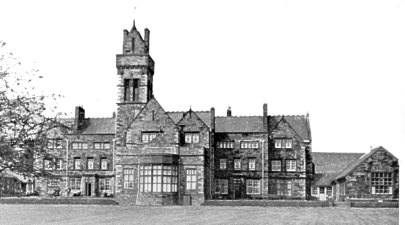
Original building, designed by J.H. Christian - demolished 1998

Original building, designed by
J.H. Christian - demolished
1998
THE ASYLUM'Tis built, and not too soon, I think,
For many hundred years o'er all the Isle,
In towns and villages along the shore,
On the wide Curragh, up among the hills,
Along the plains, and o'er the lonely moors,
High up by the valley of the Sulby stream,
Amongst the giant boulders on the base
Of Snaefell's rugged height— there wandered free
The Tom o' Bedlams of our Mona's isle;
The Peter Greys, and Bettys of the Drun,
Were everywhere — outraging decency,
In rags that made the nakedness more sad
Than Indian Fakeer of the Himalaya hills.
Now the Asylum's built, a noble pile,
A home for all — well worthy of the Isle.J.E. Pattison 'Manxiana' 1870
In 1794 David Robertson had been very critical of the lack of provision:
while in the whole Island there is no public establishment for sheltering the destitute, protecting the insane, restoring the sick, or supporting the poor.
The first official provision for the insane was in 1815 when Castle Rushen was converted for use as a gaol and a place to incarcerate those lunatics whose families could not cope with them, though several were taken to private asylums in England or Scotland if funds could be found. An Act of Tynwald of 1849 allowed for the safe custody of insane persons within Castle Rushen who were however to be kept separate from the prisoners. The same act also provided that a fund be set up for the building of an asylum - Governor Hope in 1851 encouraged the provision of an asylum stating that there were 'a considerable number of lunatics on the Island who ought, both for their own safety and for the safety of others, to be placed in confinement'. Some £1500 was collected in subscriptions but lost by the failure of Holmes' Bank in 1853.
J Brown in his 1881 history summed up the situation
Among other ameliorative movements commenced at this time was one for making proper public provision for the unfortunate imbeciles who had hitherto been left in the charge of their relatives and friends. Many of these poor creatures it appeared had been shamefully ill-treated by those who had charge of them, and harrowing accounts were published in the Insular newspapers of the cruelties inflicted upon them, and of the wretched condition in which many of them dragged out their existence. Moved by these representations and by the strong pressure placed upon them by the Imperial Government, the Insular Legislature began to take steps towards removing the scandal. In 1853, Governor Hope and Bishop Auckland, on behalf of the country, purchased the Rushen Abbey estate with the intention of converting the mansion house upon it into a lunatic asylum. Later, measures were taken for imposing a general Asylum Rate upon the country; but in March, 1861, the Tynwald Court decided that the Abbey House was unsuitable for the purposes of an asylum, and passed an Act for revoking the Deed of Sale and restoring the premises to their former owner, the Rev. Mr Ward. At a Tynwald Court held on August 19, 1862, it was decided to purchase a plot of land at the Strang, near Douglas, at a cost of about £2,000.
In 1853 Rushen Abbey was bought with an eye to conversion to an asylum but never used for this purpose and the sale cancelled. Complaints about conditions in Castle Rushen continued and eventually in 1860 an act was passed, after much opposition, for the construction of a Lunatic Asylum to be funded by a property tax. In 1862 the site near Strang Village was purchased but until the building was completed in 1868, a temporary asylum was established from 1863 at Oatlands in Santan.
It was estimated at the time that there were some 100 mentally ill people being cared for in the House of Industry or other 'Poor Houses' as well as Castle Rushen.
In 1864 J.H. Christian's plans for an asylum capable of housing some 110 persons was accepted with a total cost of around £15,000 for the building and associated work. Ballamona was opened on 2 June 1868 at a total cost of £15,149 split almost 50:50 between London and the Island rates. - some 76 patients were admitted but soon facilities were found to be inadequate. Some 20 extra beds (+ additional facilities) were added in 1878 but would not appear to have solved the problems for in 1882 a report was commissioned of Dr. Clouston (from Edinburgh).
He reported in 1883 that provision for some 180 patients should be provided and in criticising the buildings he said 'It is an extraordinary combination of architectural ambition, with internal insufficiency'. Extra building work was approved and the hospital saw further expansion throughout the 20th century.
W.T Radcliffe estimated some 200 patients in the 1890's; in 1925 there were some 254 at the hospital with a further 65 at the nearby Home for the Poor.
Changes in psychiatric medicine and the advent of 'care in the community' saw most of the need for a hospital like Ballamona disappear from the 1980's onwards. The site was chosen to form that for a new hospital for the Island and the original hospital block with its distinctive tower demolished 1998/9.
Ballamona Hospital 1868-1968 Souvenir Program 1968 - Includes an excellent history of the hospital and provision on the Island for mental illness during the 19th century.
See also A.W.Moore History of IoM pp576/8
|
|
||
|
Any comments, errors or omissions
gratefully received The
Editor |
||